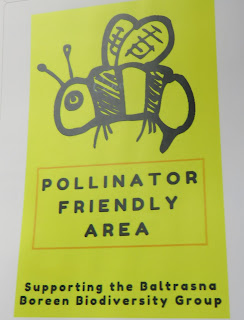The Light Emerald (Campaea margaritata) is one of several green moths: somewhat surprisingly moths do not generally have the green colour of leaves and grass for camouflage.
We saw the first of the annual damselflies — the Common Blue Damselfly (Enallagma cyathigerum)— resplendent in its vivid blue. In the past week Grace and Annie, while surveying the flora of the canal bank, saw the Blue-tailed Damselfly (Ischnura elegans) and the Banded Jewelwing (Calopteryx splendens).
The young people asked about cuckoo spit that they observed on some of the plants. It's a white frothy liquid secreted by the nymphs of insects called Froghoppers (Cercopidae). The liquid protects the nymph from predation. It doesn't damage the plants.
Again the weather was poor and we saw very few butterflies and bees. By late June we should have been seeing good numbers of Ringlet and Meadow Brown butterflies (instead saw only Speckled Wood and Small Tortoiseshell). They have since appeared but in small numbers. Then again the grass has been cut short for about two metres on either side of the path and that has inevitably reduced the numbers.
Our main focus was on three of the four types of orchid which we see on the canal — the Common Spotted Orchid (Dactylorhiza fuchsii), the Pyramidal Orchid (Anacamptis pyramidalis) and the Common Twayblade (Listera ovata). The last of these, being pale yellow or green, is hard to see and takes some practice to find. The fourth orchid, the Fragrant Orchid (Gymnadenia conopsea), flowers later and will be admired on our July walk. All of these orchids are relatively rare in Ireland now and should never be picked.
During the month Gerry had the first sighting in 2016 of a Common Kingfisher (Alcedo atthis). This is very good news as these beautiful little birds were often seen before the two harsh winters of 2009 and 2010. It uses overhanging branches (1-2 metres above the water) to watch for fish, so you might like to eye up some suitable places along the canal bank. Although 60 per cent of its diet is fish, it also feeds on insects.
As well as the project undertaken by Grace and Annie on the canal bank, Ruairí and Eoin have begun a quadrat study of grassland flora. many thanks to Eugene, who constructed a square-metre quadrat for us to use.
This fascinating study is being done in response to a request from the National Biodiversity Data Centre as part of its National Sampling Framework. We have completed two studies in Lesley’s garden and two on the high bank.
Two families have had some success in establishing wildflower meadows in their gardens even in this first year. We're collecting seed from the meadow in Lesley’s garden for distribution. Orchids appeared along the road in two areas of uncut grass, showing what may happen if you leave an uncut area (it's only likely to happen if the grass hasn't been improved and is effectively the same as the surrounding fields).
Waterways Ireland have given us small notices to put outside our gardens. We hope each family will use one to help raise awareness.
Date:
25 June
2016
Time: 12-1
Attendance: 13 (including 5 children)
What
we observed and talked about —
Bee: Bombus pascuorum
Butterflies: Small Tortoiseshell, Speckled Wood
Damselflies: Common Blue Damselfly
Flowers: Arrowhead, Bramble, Common Bird's-foot Trefoil, Common Knapweed, Common Nettle, Common Plantain, Common Spotted Orchid, Common Twayblade, Creeping Buttercup, Dandelion, Dog-rose, Field Bindweed, Ox-eye Daisy, Prickly Sowthistle, Pyramidal Orchid, Red Clover, Silverweed, White Clover, Yellow Flag, Yellow Water-lily
Hoverflies: Helophilus sp.
Macro moths: Common Carpet, Elephant Hawkmoth, Green Carpet, Light Emerald
Micro moths: Barred Fruit-tree Tortrix, Brindled Plume
Trees: elder, hawthorn




No comments:
Post a Comment